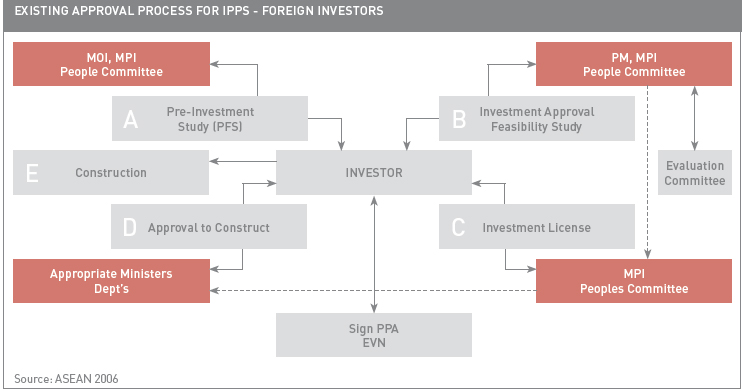Click here to register!
Wind Energy Country Analysis Vietnam
Wind energy potential
Vietnam’s wind energy potential is considerably higher compared to Thailand, Laos or Cambodia32. A World Bank survey estimated the total potential of wind power at 513 360 MWequivalent to 200 times the output of Southeast Asia’s largest power plant, the Son La Hydroelectric Plant in northern Vietnam and ten times the entire national capacity forecast for 2020. Vietnam’s wind potential is significant in the central coastal region including Quang Binh, Quang Tri, Thua Thien-Hue and Binh Dinh and the south, including Ninh Thuan, Binh Thuan, Lam Dong, Tra Vinh and Soc Trang.33 Since the 1980s, the Institute of Energy (IE) was commissioned by the Ministry of Electricity (now Ministry of Industry and Trade) to review the erection of wind turbines on islands and in remote grid connected areas. Observations and calculations showed that around 28 000 square kilometres of Vietnam have average wind speeds of 7 m/s to 9 m/s at a height of 65 meters. For instance, the average speeds at 65 meters is 7.6 m/s in Bach Long Vi, 6.3 m/s in Spratley, 6.8 m/s in Phu Quy, 4.9 m/s in Hon Dau, 4.4 m/s in Co To. 3TIER34 is a global leader in weather-driven renewable energy assessment and forecasting for wind projects of all sizes. It is able to provide high- level wind data including a wind energy potential map in Vietnam.
Framework Conditions for Wind Energy
Goal for the use of wind energy
The Ministry of Trade and Industry is developing a Strategy and Master plan for Renewable Energy Development of Vietnam for the period up to the year 2015, with outlook to 2025. 35 Under this plan, renewable energy will increase to 5 % of the total national energy output, with wind and solar power accounting for half of the amount. There is no dedicated strategy for wind energy.
Legal conditions and support instruments
Vietnam is lacking a legal framework for the implementation of wind energy projects. There is no support mechanism in place that gives investors the required security for their investment.36 This explains why MOIT in cooperation with the German Technical Cooperation (GTZ) is carrying out a project entitled »Establishment of legal framework and technical assistance for grid-connected wind power development in Vietnam«.37 One of the main goals of the project is to design a price-based support mechanism for wind energy that should come into effect by the end of 2010. The main incentive by the Vietnamese Government is a 100 % tax exemption for imported wind power technology and equipment. In addition, investors in wind energy projects have a land rent exemption over a certain period of time.
Permission procedures
The guidelines for potential foreign investors in wind power in Vietnam have been published by EC ASEAN Energy Facility. 38 The permitting procedures for energy projects are relatively complex and possibly act as a disincentive for potential investors. The following Figure summarizes the process developers of private power projects have to follow in order to get approval to invest. Prospective IPPs must carry out detailed investigations and establish a business entity under which they can apply for investment approval followed by a construction permit.




















